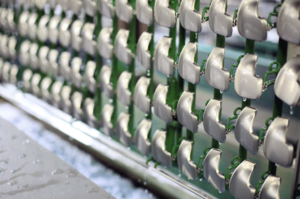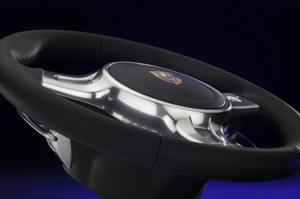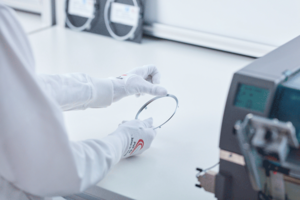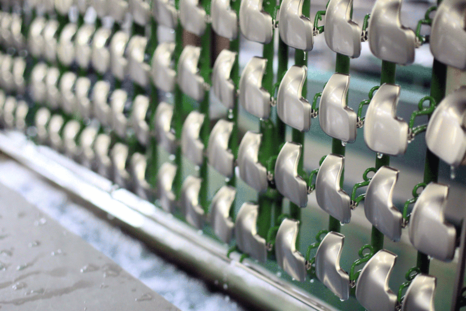Plastic electroplating
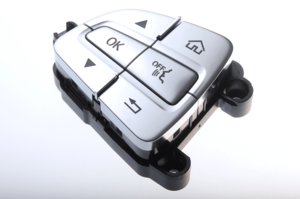
We come into contact with galvanised plastic components on a daily basis: Whether on the shower head handle, the buttons on the coffee machine or the car door handle. Plastic electroplating plays an indispensable role in our day-to-day lives in particular, as galvanised plastic parts provide a unique way of combining the properties of plastic with those of the deposited metals.
The electroplating of plastics makes it possible to create a wide range of individual matt or glossy, high-contrast surfaces. And not only are they high in value and attractive to look at, they also have pleasant haptic qualities – metallic and cool.
The base material: Plastic
The thing that makes this technology so unique is the base material. After all, plastic is lighter and less expensive than metal, and can also be adapted to meet any engineer or customer requirements with regard to shape and design. The tool-making and subsequent injection moulding processes provide a range of opportunities for the visual adaptation of the components, without the need for any complex reworking such as grinding or polishing.
The use of plastic as a base material for the subsequent galvanic processing is also environmentally friendly as the material can be recycled.
ABS/PC-ABS or fibre-reinforced polyamide is usually used as the base material for plastic electroplating. ABS stands for acrylonitrile butadiene styrene, and PC for polycarbonate. PC-ABS is a blend of these two materials, which combines the good processability of ABS with the mechanical properties of PC such as impact-resistance and heat-resistance. Polyamides also have good properties with regards to resilience and resistance. Multi-component plastics are used in the case of particular requirements, as they allow for an extremely precise, selective metal coating.
On top: metal
No metal deposition without conductivity – there's no escaping physics. The plastic components therefore need to be chemically pre-treated in order to achieve the necessary conductivity for the subsequent metal deposition processes.
Butadiene is selectively separated out of the surface via the conditioning of the plastic components (ABS). The resulting caverns form the basis for the adhesion of the following metallic layers. During the activation process step, palladium seeds are placed into the tiny hollow spaces in this pre-treated surface. These ions are then converted to conductive metallic palladium during the subsequent reduction step.
When processing polyamide (PA), the first step only involves soaking the surface, as these single-phase thermoplastics do not oxidise as part of a conditioning step. In this case, microroughness is formed rather than caverns.
The first thin metallic layer (Ni) is deposited onto the component chemically, i.e. without any current. This establishes the conductivity. Electrolytic metal deposition takes place in the subsequent steps.
This nickel layer is then galvanically reinforced in order to eliminate any subsequent adhesion problems and to ensure better current transfer during the subsequent electrolysis. The components are then copper-plated. This ductile, soft layer ensures thermal expansion compensation in the event of changing temperatures, at which plastic and metallic layers behave in considerably different ways. This layer also ticks another box as a result of its levelling and shiny effect.
After this process (Cu) is complete, different nickel layers can be applied on the component either individually or in combination. This defines the differences between the gloss and matt levels on the component, for example. The chrome layer is then applied. This final surface (mck or mpk) provides protection against wear, and meets the high demands with regard to corrosion resistance.
The total layer thickness of the applied metal depends on the intended future use of the product. The usual principle here is that the higher the strain (e.g. automotive exterior), the higher the total layer thickness.
Wide-ranging benefits of plastic electroplating
The weight savings are certainly one of the most important arguments in favour of galvanised plastics – particularly in automotive engineering, where every gram matters. However, this also applies to many other day-to-day objects that also need to be pleasantly light as well as being perfect in appearance. The fields of application here range from coffee pots and umbrella handles right through to mobile telephones.
The almost unlimited design options are another key benefit, along with the perfect look of the galvanic coating, whether chrome, silver or gold, and whether glossy, matt or brushed, and which turns every smooth plastic blank into an attractive product.
Additional technical benefits include the high levels of corrosion protection and adhesive strength, the abrasion-resistance and scratch-resistance and the resistance to temperature and weathering.
Plastic electroplating can also be used as "shielding" against electrosmog – an aspect that shouldn't be overlooked in today's electronic age. Without metallic layers, the plastic housings of electrical and electronic devices would be permeable to electromagnetic waves. Electroplating technology makes it possible to achieve uniformly thin but particularly dense layers with optimal attenuation values.
Plastic parts that are both decorative and functional therefore have a wide range of different fields of application, from the electronics sector to automotive interiors and exteriors, to furniture fittings and sanitary fittings, household items, film and photographic cameras or watches and jewellery.
There are high demands with regard to quality, and these need to be carefully monitored. The most demanding area here is the automotive industry.
Extremely high quality demands
Constant monitoring, continuous quality controls, extremely high standards – in Germany, surfaces are coated using state-of-the-art, fully automatic electroplating systems. Good economic efficiency and environmentally friendly technology allow for an optimal process sequence, with top priority always given to regeneration and (re)-use, environmental compatibility, safety and occupational protection.
In compliance with all standards and regulations, the galvanised components are tested after processing using the latest measuring and testing equipment in order to guarantee an attractive surface and a long service life.




